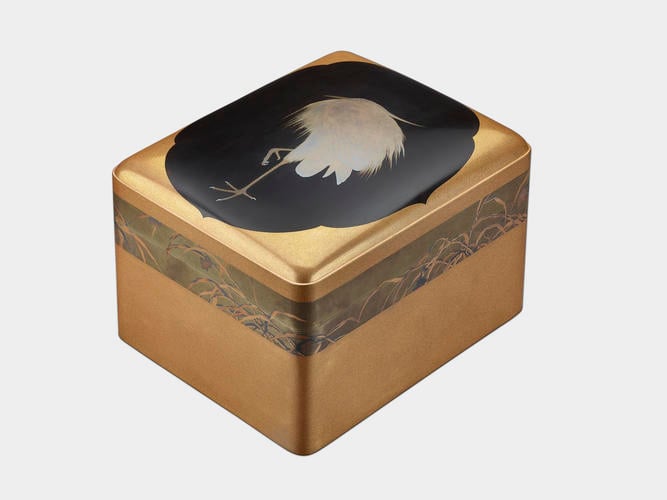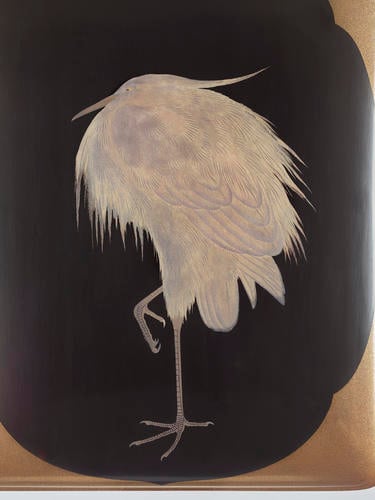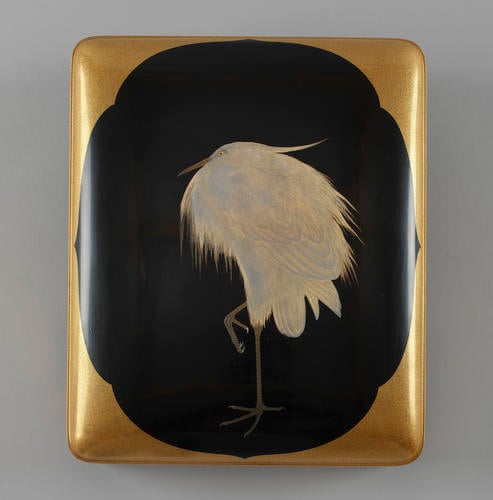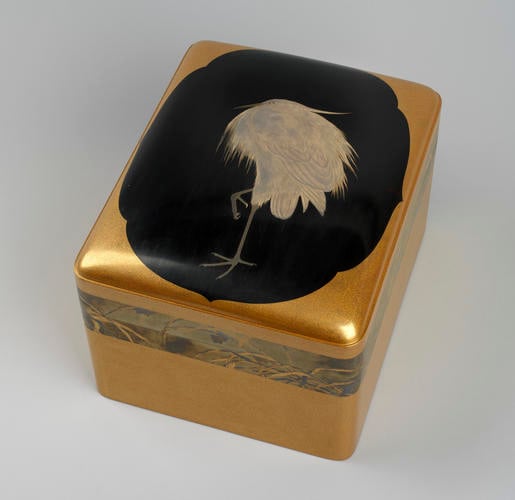-
1 of 253523 objects
Lacquer box decorated with a heron c. 1890-1905
Black, gold and silver lacquer on wood | 23.2 x 27.5 x 33.5 cm (whole object) | RCIN 39503




-
The Emperor Shōwa sent this rare and refined piece to Her Majesty The Queen as a Coronation gift in 1953 – just one year after Japanese-British relations had been normalised by the Treaty of San Francisco, signed in 1951 and brought into force in 1952. The presentation of this first post-war diplomatic gift was therefore of great significance, and the Imperial Household evidently sought a piece of the highest calibre.
This exceptional box is the work of Shirayama Shōsai, one of the most prestigious lacquerers of the Meiji and Taishō eras. Today, fewer than 70 examples of his work are known in Japan, Europe and the United States.
Here, Shōsai presents one of his favourite subjects – a heron – with a combination of exceptional boldness and delicacy. Soft white feathers are carefully rendered in silver lacquer, accented with minuscule gold lacquer streaks and contrasting dramatically with Shōsai’s trademark ground of lustrous black. The latter has been highly polished to achieve a deep, mirror-like finish. On the underside of the lid, six black crows surround a bare plum tree. Shōsai combined herons and crows on several occasions,and together they evoke the hard winter season. The heron’s posture, nestled in its feathers, reinforces the chilly atmosphere.
In 1890, Shōsai exhibited a cosmetic box bearing a white heron at the Third National Industrial Exposition in Tokyo. The design was taken from a painting by Kanō Tsunenobu (1636–1713) and praised by the jury as a ‘first rank’ piece.This may be the same box, or a very similar design. The signature which appears here is not inconsistent with the way Shōsai signed his work at that time, which could make this one of the few known works from his early independent output.
Shōsai had been instrumental in the re-establishment of lacquer (urushi) as a revered art form during the Meiji period. In 1880, he began working for the semi-governmental export company, Kiritsukōshōgaisha, and it was there that he took his art name, Shōsai. In 1890 he became a founder-member of the Japan Lacquer Society (Nihon shikkōkai), and he subsequently did much to promote recognition of lacquerers as individual artists – a status enjoyed in the Edo period but largely lost during the export-focused years of the Meiji restoration. In 1906, he was made an Imperial Household Artist (Teishitsu Gigei’in).
Text adapted from Japan: Courts and Culture (2020)
Full description: A deep, rectangular document box, with flush-fitting cover, rounded corners and a domed top. In a large quatrefoil panel of lustrous black, set in the fundame ground on top that also covers the sides, a large heron standing on one leg, in silver lacquer with gold streaks among the feathers and beak, and a gold and black eye. Round the sides, linking box and cover, a black band with curving grasses in gold in reserve. The inside of the lid showing on the same gold ground an aged prunus tree in silver, with four perching and two flying black crows, and a mountain top beyond.Text adapted from Chinese and Japanese Works of Art in the Collection of Her Majesty The Queen: Volume III.
Provenance
Sent to Queen Elizabeth II by the Emperor Shōwa on the occasion of her Coronation, 2 June 1953
-
Creator(s)
(nationality)Acquirer(s)
-
Medium and techniques
Black, gold and silver lacquer on wood
Measurements
23.2 x 27.5 x 33.5 cm (whole object)
Category
Object type(s)
Other number(s)
Alternative title(s)
Cosmetic box and cover (tebako)
Place of Production
Japan